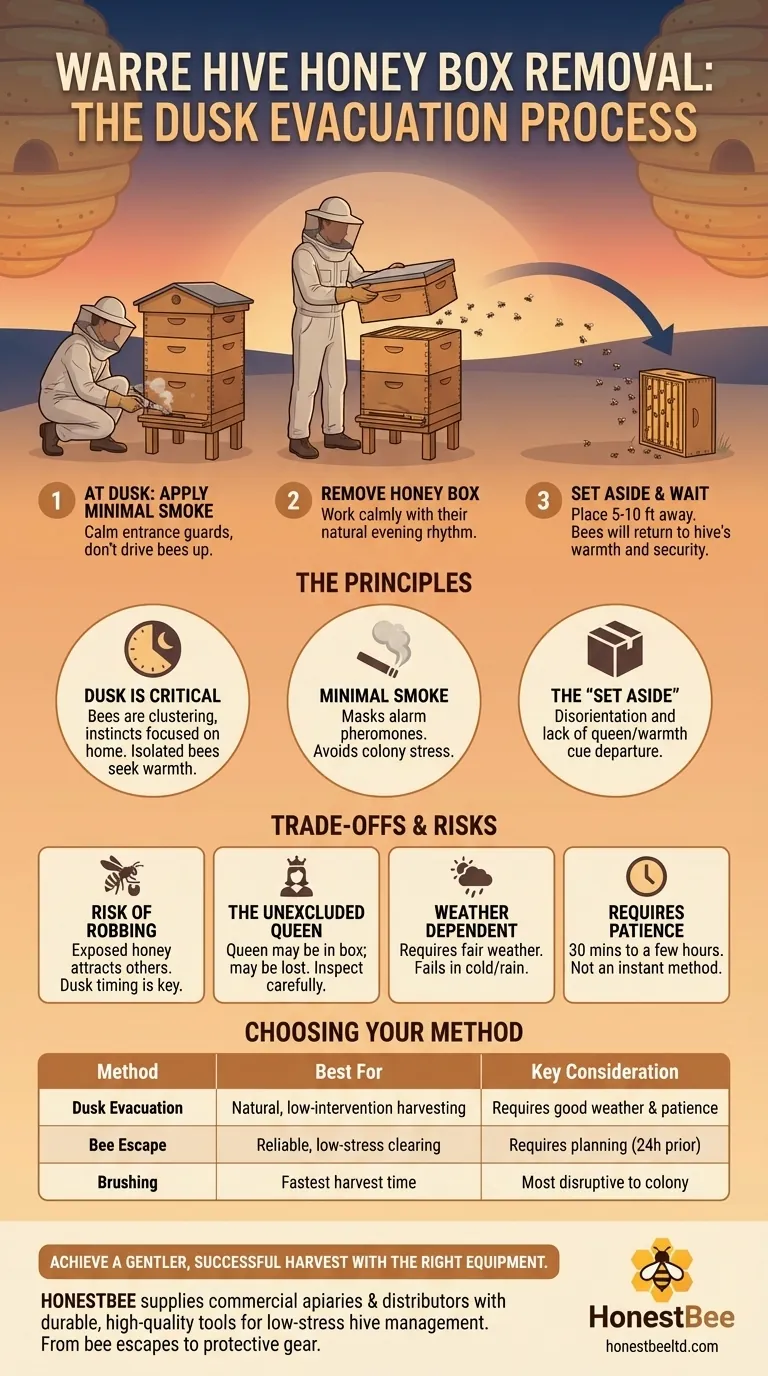To remove bees from a Warre honey box, the traditional and philosophically aligned method is a passive evening evacuation. At dusk, you apply a minimal amount of smoke to the hive entrance, remove the honey box you wish to harvest, and place it on its side several feet away. The bees, driven by their instinct to cluster for the night, will leave the isolated box and fly back to the security of the main hive.
The core principle of clearing a Warre box is not to force the bees out, but to create a situation where they choose to leave on their own. This leverages njihov natural evening behavior to achieve a low-stress harvest that aligns with the Warre philosophy of minimal intervention.

The Principle Behind Passive Evacuation
The method લોકો prefer for clearing a Warre hive is rooted in understanding bee behavior. It is designed to be as gentle and non-disruptive as possible.
Why Dusk is the Critical Time
At the end of the day, foraging bees are returning home, and the entire colony is preparing to cluster for the night. Their navigation and instincts are entirely focused on rejoining the warmth and safety of the main hive.
By separating the box at this specific time, you are working with their natural daily rhythm, not against it. Bees in the removed box will feel isolated and cold, motivating them to abandon it and fly the short distance back to the familiar scent and warmth of their colony.
The Role of Minimal Smoke
A puff or two of smoke at the entrance is not meant to drive bees upward or out of the box. Its purpose is simply to mask કામદાર મધમાખીઓ દ્વારા છૂटा કરાયેલા alarm pheromones.
This calms the entrance guards, preventing a defensive response as you begin to work the hive. Using excessive smoke is counterproductive and stressful for the colony.
The "Set Aside" Technique Explained
Placing the removed box on its side, 5 to 10 feet away, accomplishes two things. It physically disconnects the box from the hive, and it orients the combs vertically, which is unnatural for bees inside a dark hive.
This slight disorientation, combined with the lack of the queen's pheromones and the colony's warmth, is the final cue for them to leave. They will exit the box, re-orient themselves, and fly होम.
Understanding the Trade-offs and Risks
While this method is beautifully simple, it is not foolproof. Acknowledging the risks is critical for a successful and responsible harvest.
Risk of Robbing
Exposed honey is a powerful attractant. Performing this removal at dusk इज key because most foraging bees from other colonies have already ceased flying. Doing it earlier in the day poses a significant risk of initiating a robbing frenzy, where bees from other hives descend on the box and your hive.
The Unexcluded Queen
Warre beekeeping typically avoids the use of queen excluders. This means there is a small but real possibility the queen could be in the honey box you are removing.
If the queen is in the removed box, she may not successfully return to the hive and could be lost. Always work calmly and be prepared to inspect the ground around the box for the queen if you suspect she was inside.
Dependence on Weather
This method is entirely dependent on fair weather. It will not work on cold, rainy, or excessively windy evenings.
Bees will not willingly leave the relative shelter of the honey box to fly back to the hive in poor conditions. Attempting it in bad weather will only result in a box full of bees and chilled honey.
It Requires Patience
This is not an instant clearing method. Depending on the number of bees and the conditions, it can take anywhere from 30 minutes to a few hours for the box to become completely or mostly empty. This method prioritizes gentleness over speed.
Making the Right Choice for Your Harvest
Choosing your clearing method depends on your goals, your equipment, and the specific conditions of the day.
- If your primary focus is a natural, low-intervention harvest: The dusk evacuation method is the ideal choice, provided you have good weather and are not in a hurry.
- If your primary focus is reliability and gentleness: Using a bee escape (a one-way door placed under the honey box 24 hours before harvest) is the most dependable, low-stress method.
- If your primary focus is speed: Brushing bees off each frame individually is the fastest method, but it is also the most disruptive and likely to agitate the colony.
Ultimately, a successful harvest is one that provides you with honey while ensuring the colony remains healthy and strong.
Summary Table:
| Method | Best For | Key Consideration |
|---|---|---|
| Dusk Evacuation | Natural, low-intervention harvesting | Requires good weather and patience |
| Bee Escape | Reliable, low-stress clearing | Requires planning (install 24h prior) |
| Brushing | Fastest harvest time | Most disruptive to the colony |
Achieve a gentler, more successful harvest with the right equipment. HONESTBEE supplies commercial apiaries and beekeeping equipment distributors with the durable, high-quality tools needed for low-stress hive management. From reliable bee escapes to essential protective gear, our wholesale-focused operations ensure you get the professional equipment your operation depends on.
Contact HONESTBEE today to discuss your wholesale supply needs and ensure your next harvest is a smooth success.
Visual Guide

Related Products
- Long Langstroth Style Horizontal Top Bar Hive for Wholesale
- HONESTBEE Professional Long Handled Hive Tool with Precision Cutting Blade
- HONESTBEE Advanced Ergonomic Stainless Steel Hive Tool for Beekeeping
- Professional Dual-End Stainless Steel Hive Tool for Beekeeping
- Professional Multi-Function Stainless Steel Hive Tool
People Also Ask
- What is a top bar bee hive? A Natural, Low-Stress Beekeeping Solution
- How does the top bar hive help control varroa mites? A Natural Approach to Mite Management
- How does the design of a top bar hive benefit beekeepers? Ergonomic & Natural Beekeeping for Hobbyists
- What are the benefits of the top bar hive? A Guide to Ergonomic, Natural Beekeeping
- What are the main differences between Langstroth hives and top bar hives? Choose the Right Hive for Your Beekeeping Goals



















